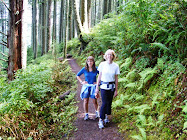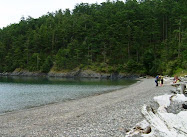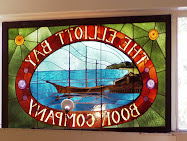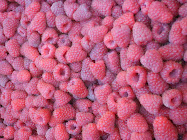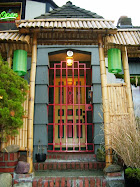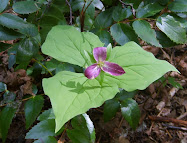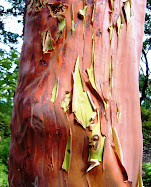 |
| Lena points out a salmon hanging in the pool in Piper's Creek |
A simple, miraculous pleasure.
While I will never completely understand how salmon make their way back from the mighty ocean to their small home stream, it's a thrill to see them answering the call of their biological imperative: spawn and die.
As I park and hop out of the car at the environmental learning center parking lot in Seattle's Carkeek Park, several volunteers are gathering, clipboard and pens in hand.
"Is it a good run this year?" I ask.
"Yes," says friendly volunteer Barb, "It's the best run in 9 or 10 years, and the fish are really big."
With that I skitter down the wooded trail to the best viewing spots along Piper's Creek, which runs through a gulch rimmed with second-growth lowland forest. On this rainless, sunny weekend after Thanksgiving, lots of people are out to celebrate and see the returning salmon. It's quite a popular outing for families with small kids.
 |
| A big salmon was spotted right underneath this footbridge. |
At the junction of Piper's Creek with Mohlendorph Creek (a small tributary), I see two grayish-green chum salmon hanging in a pool on the opposite stream bank, below some overhanging tree roots. Occasionally they surge forward with a splash, and then drop back.
After meeting up with several friends, we hopscotch along the creek toward Puget Sound, spotting about half a dozen salmon in varying stages of dying, death, and decay.
"They release about 300,000 fingerling salmon into the stream and usually around 300 or so make it back," a pony-tailed young man tells us. As of midday November 24, there were 363 chum salmon counted entering the creek so far, and a smaller percentage of the more rare coho.
Alas, since Piper's Creek is in an urbanized watershed (too many toxins in the runoff and too much water entering the stream without natural filtering), the salmon run needs to be supplemented with hatchery fingerlings. Years ago early settlers logged off all the old growth and trashed the stream in this watershed, and the original salmon runs were extirpated/destroyed.
Regardless, with the efforts of local volunteers, tribes, and the Washington Department of Fish and Wildlife, salmon have been returning to Piper's Creek again for many years.
 |
| This guy would probably rather be chasing a ball than watching for salmon |
While it's hard to get a shot of the salmon in the stream, I get a few shots of some carcasses on the beach that washed back out to the Sound with the heavy rains.
 |
| Male chum salmon carcass |
So grab those rainless days here in the Northwest while you can this time of year. Get on out to the beach, the woods, or your nearest park if you can't make it to Carkeek or another salmon stream. If you see something amazing like salmon spawning or bald eagles hunting, remember you're just bearing witness to what's been going on for milennia around here.
 |
| Looking south from Carkeek beach to Meadows Point and beyond |
When You Go
Peak viewing for the Piper's Creek salmon are from about the third week in November to the second week in December. So you've still got time to catch the action. Carkeek Park is located in NW Seattle. Take I-5 exit #173 going either north or south. Proceed west on Northgate Way (turns into NW 105th) to 3rd Ave NW. Turn right on 3rd Ave NW to NW 110th. Then turn left on NW 110 (turns into Carkeek Park Road). Go through park to Salmon Viewing Areas. Parking is available nearby. Or take Metro Bus #28 and get off at Eddie Mcabee entrance across from QFC, or at NW 113th and walk to Salmon Viewing Areas (along the Lower Meadow trail in this map).





















































